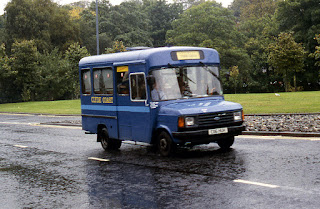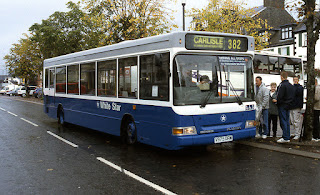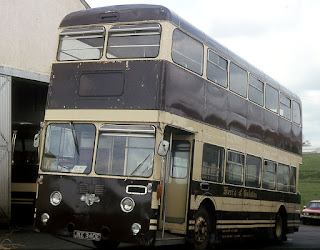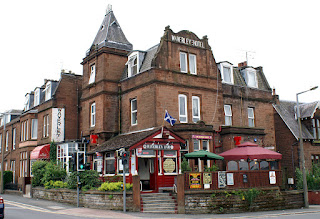Despite the title of this post, Western SMT was once the main bus operator in Kilmarnock. In the town's depot we see a former Bristol Lodekka cut down to a towing vehicle.
In the bus station we find this Leyland Leopard/Plaxton, purchased by Westernn SMT with the services of Paton Bros of Renfrew.
One of the last liveries applied to Western SMT buses is seen on this Leyland National. Kilmarnock bus station, 1993.
Western SMT was later sold to the Stagecoach Group. This photo is from 1996.
Kilmarnock represented the southernmost normal terminus of the A1 Services co-operative. There was a bus station/depot in the town.
By 1977, A1 was using the town's new bus station. Here's a rare Volvo Ailsa/Van Hool McArdle.
The services of A1 were also taken over by Stagecoach. This ex London Leyland Titan has received the A1 identity in 1996.
Several Stagecoach buses were painted into A1 colours!
There were several small operators running services in Kilmarnock after deregulation. These included Clyde Coast and Shuttle Buses.
To Kilmarnock railway station now, where we find 76097 in a bay platform.
Class 156 units later handled the majority of services at Kilmarnock, two being seen here in different Scotrail liveries.
We now leave Kilmarnock behind and head north for a couple of miles to Kilmaurs, where we find the Weston Tavern, a fine boozer at the time of the photo (1990s), but now it describes itself as a "gastropub".
A couple of miles away is the village of Crosshouse, where certain constituents of the A1 Services co-operative kept some vehicles.
Another company, Gilmour's Coaches, was also based in Crosshouse.
To the south, on the Kilmarnock to Barrasie line, was Gatehead station, long closed, but the signal box was still there in 1983, controlling the level crossing.
More A1 vehicles were garaged at nearby Dreghorn.
Now we come to the town of Irvine and, in the town centre, we call in at the Turf Hotel. It's on CAMRA's heritage pubs list.
Down by the harbour is the Ship Inn. Sadly, it is closed long-term at the moment.
Happliy, not far away is the Marina Inn.
We'll look at the rest of Irvine and places nearby in the next post.













































































